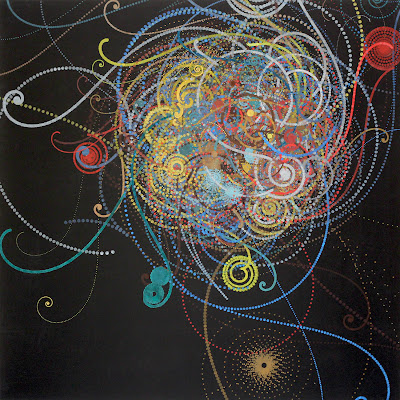BEAUTY IN THE VORTEX : THE PAINTINGS OF CARTER HODGKIN
The nature of abstraction is that it diverges
from a representation of the natural world in order to achieve its aims. It may
begin with the real—with what we accept as a real object, event, or fact, and
then break down into constituent parts that in themselves hold as much
realistic value as the quarks that make up all matter, but for whom we can
ascribe no specific appearance. The distance between an object and its
portrayal in art is a degree of abstraction, and likewise the distance between
knowledge and experience is also abstraction.
In the new series of paintings by Carter
Hodgkin, we are presented with an abstract aesthetic borrowed from a sphere of
encounter not belonging to everyday life. Hodgkin likes to mine real localities
that result in forms that she can pick depending upon their rate of natural
occurrence, their material state, and their usefulness to us as facts.
Hodgkin refers to the designs in her paintings
as referencing “cosmic collisions,” in which a locus of gravity between certain
planetary bodies causes random attraction of smaller fragments, as well as
gravitational interruptions by asteroids shooting away from suns that have gone
supernova millions of miles apart from one another. All the various elements
are pulled together by these gravitational arenas, creating a dense inertia that
creates endless interactions with explosive and colorful results.
Hodgkin is specifically attracted to what I
call the “esthetic of the non-event’ which could otherwise be described as any
event, however distant or miniscule, happening in a location or zone far
removed from the sensory or causal context of the everyday. It could be the
formation of cells in the blood or the destruction of random elements of the
concrete universe at great alienation from life on earth. The merging,
metamorphosis, and dissolution of matter, are of primary interest to an artist
devoted to the medium and practices of abstraction because they root out the
actual bases for it, connecting
the artist to the world.
The practice of painting in Hodgkin’s case
becomes more than an immersion in idealized form, but a partnering with real
events that require their depiction in art in order to be understood as real
and symbolic. Her new body of work is comprised of drawings and paintings that
are matched to a series on ongoing digital animations that actually track, and
stylistically narrate, the material transformations themselves. However, there
yet remains a variable of the unknown, even of the pictorially impossible in
her new work, and it is this degree of uncertainty, as well as the forms
themselves, that drives her to explore them.
There is an evolutionary spirit
alive in this work, tracking the variables of creation and destruction, and the
appearance of disorder in a greater order than can nominally be imagined.
Hodgkin starts at the periphery of the imagined event, taking one color of
paint at a time and tracing a gesture toward an unspecific latitude where she
feels the event must occur. Each step toward the event is a single mark and all
the marks of a single line are by necessity uniform and precise. As random
processions of marks converge at a single location, it becomes cumulatively
massive, alternating in the approaching materials, and then darkening and
becoming dense and mysterious. This is the very beginning of what will become a
planet. Yet for now all it needs be is a miracle in the making. Hodgkin is
alone in the vortex but takes us with her. There is beauty here which she alone
can show us.

Comments